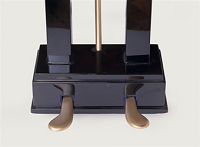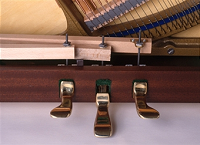
Home > Piano Techniques > Using the Sustain Pedal
|
||||
Using the Piano Sustain Pedal Properly
Even without the dampers on the string, the note still eventually fades out. The sustain pedal is more often needed in slow songs where notes are commonly held for much longer lengths of time. The basic operation of using the piano sustain pedal is very straight forward. Just prior to hitting the note you want to sustain, you press down on the pedal. When you are done sustaining the note, you release the pedal. The note does not necessarily stop playing when you release the pedal. Releasing the pedal places the damper back onto the string, but if the string is still vibrating with enough force, it can ring for a noticeable amount of extra time. In most cases, the length of time is negligible and can be ignored. In some cases, you want to sustain a note, but you do not want it to ring out past the duration of the note. There are two options for dealing with this situation. One option is to release the pedal a little bit before the end of the note, giving the dampers time to soften the vibrations of the string before the note ends.
The sustain pedal can also be used to partially raise the dampers from the string by pressing the pedal down part way. The damper is still in contact with the string, but is not pressing down with the normal amount of force. The notes play for longer with the dampers partially off the strings, but not as long as when the sustain pedal is fully pressed down. The tone of the strings also changes slightly. Most pianists are unlikely to use this technique very often, but it is a proper way to of using the piano sustain pedal and some piano songs do call for it. The sustain pedal allows you to let notes and chords ring for longer than normal on the piano. However, you have no actual control on the specific notes that are being sustained. The pedal sustains every note being played. Sometimes this might not be desirable, for example, if you want to sustain a bass line, but are playing a fast melody line, as well. In some cases, it is better to let the notes decay a little too quickly than to sustain notes that should not be allowed to be sustained. Fast melody lines do not usually combine well with the sustain pedal since they frequently use notes that should not be allowed to bleed together.
| ||||
|
Although every attempt has been made to make information as accurate as possible, we are not responsible for any errors that may appear.
 The notes in the piano are produced by vibrating strings. Dampers on each string
absorb some of the energy of the string, causing the notes to eventually decay. Using the piano sustain pedal,
a piano player can lift the dampers off the string. This causes the string to ring for a longer period of
time.
The notes in the piano are produced by vibrating strings. Dampers on each string
absorb some of the energy of the string, causing the notes to eventually decay. Using the piano sustain pedal,
a piano player can lift the dampers off the string. This causes the string to ring for a longer period of
time.
 The other option is to press down on the soft pedal, which muffles the strings
after you release the sustain pedal. This option gives a bit more control over the end of the note, but can
interfere with other notes you might be playing at the time.
The other option is to press down on the soft pedal, which muffles the strings
after you release the sustain pedal. This option gives a bit more control over the end of the note, but can
interfere with other notes you might be playing at the time.



